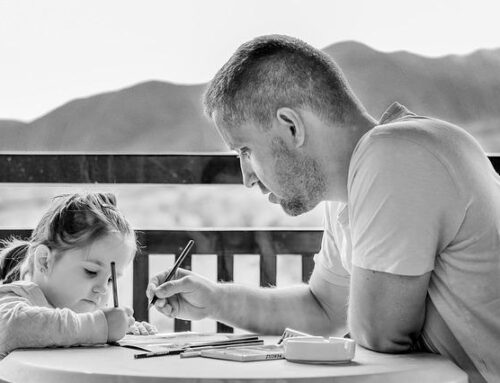Setting boundaries is one of the hardest things for someone to do. It requires inner strength to watch someone you love struggle. When I think of the topic of boundary setting, I think of a story that you may be familiar with. It involves a man who came across the cocoon of a butterfly.
One day during a walk, a man came upon a cocoon. Out of curiosity, the man decided to watch what happened next. A small opening appeared in the cocoon. After a few hours of the butterfly struggling to force its body out of the hole, it seemed stop. It appeared that the butterfly had given up and lost the strength to continue to push itself free. The man had an idea. In an attempt to be helpful, he made an incision in the cocoon for the butterfly to exit. Eventually, the butterfly did in fact leave the cocoon. However, there was an issue. The body of the butterfly was swollen, and its wings weren’t developed. Even after some time had passed, the butterfly didn’t lose its size, and the wings didn’t function for it to take flight. The butterfly was grounded for life.
In the mind of the man, he was being kind and compassionate. He was attempting to ease the struggle of the emerging butterfly. All he wanted to do was help. In the end, his kindness hindered the butterfly. See, the struggle out of the tiny hole in the cocoon was nature’s design to help reduce the swelling of the butterfly’s body, while increasing the strength of the wings. During the escape of the cocoon, the butterfly’s body-fluid is forced out of the body and pushed into the wings. This strengthens the wings and reduces the weight of the body. All of which allows for the butterfly to take flight.
This is where struggle is important in life. I don’t know about you, but I have found myself in situations where I was in a lot of emotional pain. It is through the experience of that pain, and the challenges life presented at that time, I was able to grow and develop. To be fair, it was not a willful process. I did experience the grief associated with the changes that I was confronted with. Anger, sadness, and denial. They were all present. To paraphrase the Vietnamese Buddhist Monk, Thich Nhat Hahn, we are not able to appreciate bread unless we deeply experience the sensation of hunger. The struggle is a lesson in and of itself.
When it comes to parenting, we do things as parents not because we want to, but because we believe it might be best for our children. This means that we have to allow our children to struggle. For instance, it is actually important for children to feel the sensation of boredom. Through boredom, they are forced to use their imagination and become self-sufficient in finding ways to entertain themselves. The discomfort that they feel pushes them to open their minds and do something about it.
In many cases, we don’t change unless we are uncomfortable enough. This is how some people find themselves making the call to talk to a therapist. Things in life have become uncomfortable enough to change things and alleviate the discomfort. If things didn’t reach that threshold of discomfort, then there wouldn’t be any need to make any changes. I will not change the thermostat unless I feel warm enough. Once I hit my threshold of feeling too warm, I will lower the thermostat to turn on the air conditioner. The same rule applies to the discomfort in relationships, employment, health, finances, and so on.
When it comes to setting a boundary with someone, the same theory of enough is put into application. If it is the first time a boundary is being set, then expect a lack of acceptance from the other person. This is because the other person now has to make concessions to have their needs or wants met, whereas in the past, you previously took care of such things. The resistance in their behavior is predictable.
Here is an example. Let’s say that you and your partner or child are dancing with one another. You step forward, they step backward. They step forward, you step backward. Now, change the dynamics. They step forward, you don’t move. I hope you are wearing a helmet because there is about to be some head butting. Frustrations are likely to arise, yours and theirs. If you are not calm, this can escalate rather quickly.
The frustration and anger that the other person is experiencing is that of the butterfly pushing itself out of the cocoon. It can be a painful process for them to experience, as well as for you to watch and be the instigator for. However, their discomfort is paramount for growth. Learning to do something on their own will only strengthen their wings. If at any point, you decide to help them under the pretense that you are being kind and compassionate, you are identifying with the man in the aforementioned story. If you are a compassionate and empathetic person, then this process may be a struggle for you. But patience and consistency is key to helping the other person grow on their own.
Here are the tips that I mentioned earlier:
- It is important to know that we teach others how to treat us. When you fall into a predictable pattern of behavior with someone, and then decide to change your behavior, there is likely going to be a challenging response to contend with. The first step is to expect the potential challenge to the change. For instance, every time you tell me you are hungry, I make you a hotdog. We perform this dance for years. Today you tell me you are hungry, and I tell you that you have been watching me make you a hotdog now for years and that I believe you know how to make one for yourself. I need to expect that there might be a resistance by you to the idea of making one for yourself. I have taught you that I take care of your needs of hunger whenever you say you’re hungry. Now I need to teach you to take care of your hunger by yourself.
- You may be ready to set a boundary, but it is important to know that a part of you may still want to participate in not following through. This might be because you have taken on the role of the enabler. It has become your identity in doing things and fixing problems. To not do that means you will lose that role, or a sense of identity. Therefore, you will also experience grief in not being the caregiver.
- Be consistent. No one likes to gamble when the odds of winning are zero. People gamble because there might be a one in a million chance of winning. That is enough to keep people motivated to challenge the boundary that you are setting. If the boundary is not adhered to one time out of one hundred, the game resets and the consistency needs to be reestablished. Be mindful, once you allow a boundary to be crossed, expect it to occur again in the near future and for you to be challenged more regularly.
- Saying “no” to someone doesn’t mean you are a bad person. It means that you have the capacity to let someone else do for themselves, and you are able to display a sense of respect for yourself and your time. Saying “no” might be hard at first if you have not said in the past. It might sound and feel foreign. However, if you are saying “no” with an appropriate tone and in the appropriate context, and on a consistent basis, you will see your relationships change.
- Assess how you are feeling about yourself and your self-worth. If these areas are low, then saying “no” and setting that boundary will be more challenging.
- Remember that teaching someone to do for themselves demonstrates love. Teaching your children to fly without you, instead of keeping them grounded with enabling behavior, is moving into the direction of a healthier way of parenting. Teaching your partner who has become dependent on you is a demonstration of love as well. It shows love for them and for yourself. This frees them up to feel more independent, and it allows you to be able to focus on yourself in addition to other aspects of the relationship.
- If you need help in the area of setting and maintaining boundaries, please give The Center for Trauma, Stress, and Anxiety at (443) 567- 7037 to set up an appointment with one of our therapists.





Leave A Comment